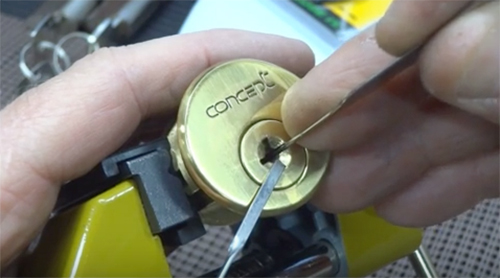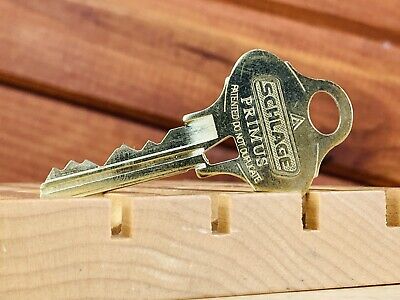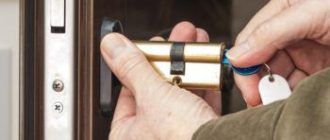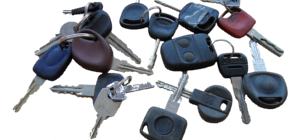
What is a cruciform lock
Locks play a crucial role in our daily lives, providing security for our homes, offices, and belongings. One type of lock that has become increasingly popular is the cruciform lock. These locks, also known as “cross locks,” offer a higher level of security compared to traditional pin tumbler locks.
So how do cruciform locks work? The mechanism of a cruciform lock involves a series of pins and tumblers that must align correctly for the lock to open. Similar to pin tumbler locks, the key has a set of ridges and valleys that correspond to the pins inside the lock. When inserted into the lock, the key pushes the pins into the correct position, allowing the lock’s cylinder to rotate and the door to be unlocked.
One advantage of cruciform locks is their resistance to bumping, a popular method used by burglars to bypass traditional pin tumbler locks. Bumping involves inserting a specially crafted key into the lock and applying a bumping force, causing the pins to jump and allowing the lock to be opened. However, cruciform locks have additional security features that make them more resistant to bumping, providing a higher level of protection for your property.
While cruciform locks offer enhanced security, it’s important to remember that no lock is completely impervious to skilled lock pickers. However, by understanding how cruciform locks work and their advantages over traditional pin tumbler locks, you can make an informed decision when it comes to the security of your home or office.
Cruciform Locks: An Overview
Cruciform locks are a type of pin-tumbler lock mechanism commonly used for providing security in residential and commercial buildings. These locks are named after their unique shape, which resembles a cross or crucifix.
Similar to other pin-tumbler locks, cruciform locks consist of a cylindrical lock body with a keyway and a core or cylinder. The core houses a series of driver pins and key pins, which need to align properly with the shear line in order to unlock the lock.
| Driver pins | These pins are located in the upper part of the lock cylinder and are pushed downwards by springs. They are different lengths and are designed to align with the shear line when the correct key is inserted. |
| Key pins | These pins are located in the lower part of the lock cylinder and are arranged in a stack. The length of each key pin corresponds to a specific cut in the key. When the right key is inserted, the key pins align with the driver pins, allowing the lock to turn. |
| Shear line | The shear line is the gap between the plug (rotating part of the lock cylinder) and the housing (stationary part of the lock). When all the driver pins and key pins align properly with this gap, the shear line is clear and the lock can be turned. |
Cruciform locks provide a reasonably high level of security, as they require a specifically cut key to align all the pins and unlock the mechanism. They are also resistant to bumping, a technique used to overcome traditional pin-tumbler locks by creating a forceful impact on the pins with a specially crafted key.
While cruciform locks offer a good level of security, they are not immune to picking and other lock manipulation techniques. Therefore, it is important to choose high-quality locking systems and regularly maintain them to ensure optimal security.
What Makes Cruciform Locks Unique
Cruciform locks are a type of pin-tumbler lock that offers a higher level of security compared to traditional cylinder locks. These locks feature a unique mechanism that sets them apart from other types of locks.
One of the main distinguishing features of a cruciform lock is its keyway. Instead of a conventional keyway, which is shaped like a cylinder, a cruciform lock has a keyway that resembles a cross. This unique design adds an extra layer of complexity and security to the lock, making it more difficult for unauthorized individuals to pick or manipulate.
The pin-tumbler mechanism in cruciform locks is also designed differently. Instead of the traditional pins that are found in cylinder locks, cruciform locks have specially shaped pins that correspond to the unique keyway. These pins are typically in the shape of a cross or a star, which fits perfectly into the keyway of the lock.
When the correct key is inserted into a cruciform lock, the pins align perfectly with the keyway, allowing the lock cylinder to rotate and unlock the door. However, if an incorrect key or a different object is inserted into the lock, the pins will not align properly, preventing the cylinder from rotating and keeping the lock securely in place.
Overall, the unique design and mechanism of cruciform locks make them a popular choice for high-security applications. Their complex keyway and specially shaped pins provide an added level of protection against unauthorized access and picking attempts. Whether it’s for residential or commercial use, cruciform locks offer advanced security and peace of mind.
The Evolution and History of Cruciform Locks
In the world of security, the evolution and history of locks have played a crucial role in safeguarding our belongings. One such type of lock is the cruciform lock, which has its own unique mechanism for providing security.
The concept of a lock can be traced back to ancient times, where simple mechanisms were used to secure doors and possessions. However, the invention of the cylinder lock in the 18th century revolutionized the field of lock technology. This new design introduced the idea of using a rotating cylinder containing a series of pins, which would align with matching notches in the lock mechanism to unlock it.
Over time, the concept of cylinder locks evolved and improved. The addition of the tumbler mechanism enhanced security, as it required the correct alignment of both the pins and tumblers to unlock the lock effectively. This added complexity made it harder for unauthorized individuals to pick the lock or use methods such as bumping to gain access.
It’s important to note that the cruciform lock is a variant of the cylinder lock. Instead of using traditional pins and tumblers, it incorporates a unique cross-shaped keyway and matching key, giving it its distinctive name. The cross-shaped keyway provides additional security, as it requires the proper alignment of not just pins and tumblers, but also the key’s protrusions and grooves.
The evolution of cruciform locks continued as technology advanced. Innovations such as anti-pick and anti-bump features were introduced to further enhance security. These mechanisms made it even more challenging for unauthorized individuals to bypass the lock’s defenses.
Today, cruciform locks are widely used in various applications, from residential homes to commercial buildings. Their reliable security features make them a popular choice for those looking for effective protection against unauthorized access.
In conclusion, the evolution and history of cruciform locks have played a vital role in the development of lock technology. From the simple mechanisms of ancient locks to the sophisticated designs of modern cruciform locks, this evolution has continually improved our security and safeguarded our belongings.
Key Components of Cruciform Locks
A cruciform lock is a type of security lock that utilizes a unique key shape and design. It consists of several key components that work together to provide a high level of security.
– Cylinder: The cylinder is the main body of the lock and houses all of the internal components. It is typically made of a durable metal material.
– Pins: Cruciform locks contain multiple pins that are arranged in a cross shape. These pins prevent the lock from rotating or opening without the correct key.
– Tumblers: The tumblers sit between the pins and the cylinder. They are designed to align with the pins when the correct key is inserted, allowing the lock to be turned.
– Keys: Cruciform locks use specially designed keys that have a unique cross shape. The key’s edges correspond to the pins and tumblers inside the lock, allowing it to open the lock when inserted correctly.
– Cruciform Design: The unique cross shape of the key and lock gives cruciform locks their name. This design adds an extra layer of security as it is more difficult to pick or manipulate compared to traditional pin and tumbler locks.
– Security: Cruciform locks offer a higher level of security compared to standard pin and tumbler locks. The combination of the unique key shape and the cross-shaped pin arrangement makes it more resistant to picking and bumping attacks.
In conclusion, the key components of a cruciform lock include the cylinder, pins, tumblers, keys, and the unique cruciform design. Together, these components provide enhanced security and protection against lock picking and bumping techniques.
How Cruciform Locks Differ from Traditional Pin Tumbler Locks
Cruciform locks are a type of security lock that differ from traditional pin tumbler locks in their mechanism and level of security. While both types of locks rely on the use of a key to align the tumblers in the lock cylinder and allow it to turn, there are several key differences that set cruciform locks apart.
One major difference is the shape of the key and lock itself. In a cruciform lock, the key has a cross-shaped or cruciform pattern, which corresponds to the cross-shaped slots in the lock cylinder. This unique design provides an additional level of security, as it is more difficult to duplicate or bump the lock.
Speaking of bumping, cruciform locks are less susceptible to this common method of lock picking compared to traditional pin tumbler locks. Bumping involves using a specially crafted key and tapping it to jar the pins in the lock cylinder, causing them to momentarily align and open the lock. However, with the complex design of cruciform locks and the unique shape of the key, bumping becomes much more challenging.
Additionally, cruciform locks typically have more moving parts or tumblers than traditional pin tumbler locks, which further enhances their security. These extra tumblers make it more difficult for anyone attempting to pick or manipulate the lock without the proper key.
Despite their added security features, cruciform locks still operate on similar principles as traditional pin tumbler locks. The lock cylinder contains a series of pins that must be aligned in order for the lock to turn freely. These pins are pushed up by springs and can only be pushed down by the corresponding cuts on the key. When the correct key is inserted and turned, the pins align and the lock can be opened.
In summary, cruciform locks differ from traditional pin tumbler locks in their unique key and lock design, increased resistance to bumping, and additional tumblers for enhanced security. These locks provide an extra layer of protection and are often chosen for high-security applications where advanced security measures are required.
Understanding the Advantages of Cruciform Locks
Cruciform locks are a type of lock mechanism that utilize a cruciform-shaped key and cylinder to provide security. These locks offer several advantages over other types of locks, making them a popular choice for many applications.
One of the main advantages of cruciform locks is their resistance to bumping, a method commonly used by criminals to open traditional pin tumbler locks. Bumping involves inserting a specially crafted key into the lock and then striking it, causing the pins to jump and the lock to open. Cruciform locks, on the other hand, have a different internal mechanism that makes bumping much more difficult and less effective.
Another advantage of cruciform locks is their increased security. The unique design of the cruciform key and cylinder makes it more difficult for unauthorized individuals to pick the lock. The complex shape and arrangement of the key pins and driver pins require precise alignment to open the lock, providing an additional layer of security.
Additionally, cruciform locks can offer a longer lifespan compared to other types of locks. The internal components of the lock are designed to withstand regular use and resist wear and tear. This durability makes cruciform locks a reliable choice for high-security applications where the lock will be frequently used.
In conclusion, the advantages of cruciform locks include their resistance to bumping, increased security, and durability. These features make them an excellent choice for protecting valuable assets and providing peace of mind. Their unique design and mechanism set them apart from other types of locks, ensuring a higher level of security for homes, offices, and other premises.
Common Uses of Cruciform Locks
Cruciform locks are widely used in a variety of settings due to their unique design and increased security features. Here are some common uses of cruciform locks:
| Residential | Many homeowners choose to install cruciform locks on their exterior doors to enhance home security. The complex tumbler mechanism within the lock cylinder makes it difficult for burglars to pick or bump the lock, providing peace of mind for homeowners. |
| Commercial | Cruciform locks are commonly used in commercial buildings such as offices, warehouses, and retail stores. These locks provide added security to protect valuable assets and confidential information. Additionally, the unique keyway design limits access to authorized personnel. |
| Institutions | Cruciform locks are also frequently utilized in institutions such as hospitals, schools, and government facilities. The enhanced security offered by these locks helps to protect patients, students, and classified information from unauthorized access. |
| Automotive | Some vehicles employ cruciform locks as an additional layer of security. These locks are often used for glove compartments, trunk release mechanisms, or even on ignition switches. The intricate design of the cruciform lock is intended to deter theft and unauthorized access to the vehicle. |
Overall, cruciform locks are an effective solution for various applications where security is of paramount importance. Their unique design and resistance to picking and bumping techniques make them an ideal choice for those seeking enhanced security measures.
How Cruciform Locks Provide Enhanced Security
Cruciform locks are a type of pin-tumbler lock mechanism that provides enhanced security features compared to traditional locks.
These locks are designed with a cylindrical body that houses a series of pins. The key, also known as a cruciform key, has a unique shape with multiple sets of teeth that correspond to the pins in the lock cylinder. When the key is inserted into the lock, the pins align at specific heights to allow the cylinder to turn.
One of the main advantages of cruciform locks is their resistance to bumping, a technique commonly used by burglars to quickly open traditional pin-tumbler locks. Bumping involves inserting a specially designed bump key into the lock and striking it to force the pins to jump, allowing the cylinder to turn.
Cruciform locks have additional security mechanisms that make bumping much more difficult. The unique shape of the cruciform key and the corresponding pins in the lock cylinder create a complex lock pattern that is not easily replicated. This makes it challenging for would-be intruders to create bump keys that can successfully open the lock.
In addition to their resistance to bumping, cruciform locks also offer increased security against picking. The complex pin configuration and unique key shape require a higher level of skill and precision to manipulate the lock mechanism. This makes it harder for unauthorized individuals to pick the lock and gain access to a secured area.
Overall, the design and technology behind cruciform locks provide enhanced security compared to traditional locks. Their resistance to bumping and picking make them a popular choice in applications where security is a top priority.
Exploring the Mechanism of Cruciform Locks
A cruciform lock is a type of cylinder lock that provides security by using a unique key and a complex mechanism. The mechanism of a cruciform lock consists of tumblers, pins, and a cylinder.
The key used for a cruciform lock has a cross-shaped blade, which corresponds to the shape of the lock’s internal mechanism. When the key is inserted into the lock, the pins and tumblers align with the cross-shaped blade, allowing the lock to be turned and opened.
The main security feature of a cruciform lock is the use of multiple pins and tumblers. These pins and tumblers are arranged in a specific pattern within the lock cylinder, creating a unique combination that only the correct key can match.
When the key is inserted, the pins and tumblers need to align perfectly in order for the lock to be opened. If the key does not match the pattern of the pins and tumblers, the lock will not turn. This makes it difficult for unauthorized individuals to manipulate or “bump” the lock open.
Cruciform locks are known for their high level of security and resistance to picking and bumping techniques. The complexity of their mechanism adds an extra layer of protection against unauthorized access, making them a popular choice for securing valuable assets and properties.
In summary, the mechanism of a cruciform lock involves the use of multiple pins and tumblers, arranged in a pattern that only the correct key can match. This unique combination provides a high level of security and makes it difficult for unauthorized individuals to open the lock without the correct key.
The Role of Key Design in Cruciform Locks
In cruciform locks, the design of the key plays a crucial role in the overall security and functionality of the lock. The key is responsible for operating the lock’s tumbler mechanism, which allows the lock to be locked and unlocked.
Cruciform locks are unique in that they use a four-sided key, shaped like a cross, hence the name “cruciform.” The key features a series of notches and grooves that align with corresponding pins and tumblers within the lock cylinder. These pins and tumblers must be precisely aligned in order for the lock to be successfully opened.
The key design determines the unique pattern of notches and grooves that correspond to the specific lock it is intended for. This pattern is carefully crafted to ensure that only the correct key can successfully operate the lock. The use of a cruciform key adds an extra layer of security, as the unique design makes it more difficult for unauthorized individuals to duplicate the key.
Due to its complex design, a cruciform key also provides additional protection against lock bumping, a technique used by criminals to quickly and quietly open traditional pin tumbler locks. With cruciform locks, the specific key design makes it much more difficult for bumping techniques to be effective, increasing the overall security of the lock.
In conclusion, the key design plays a vital role in the security and functionality of cruciform locks. The unique shape and pattern of the cruciform key provide added security measures, making it more difficult to pick or bump the lock. By carefully designing the key, manufacturers can ensure that only authorized individuals can successfully operate the lock, enhancing the overall security of the system.
Modern Innovations and Upgrades in Cruciform Lock Technology
As technology continues to advance, so do the mechanisms that secure our belongings. Cruciform locks have undergone several modern innovations and upgrades to enhance their security and reliability.
One significant advancement in cruciform lock technology is the introduction of advanced cylinder designs. These new cylinders incorporate features such as anti-pick pins and advanced keyways, making them more resistant to picking and manipulation.
Another innovation is the addition of security measures that combat lock bumping, a technique commonly used by intruders to quickly bypass traditional pin tumbler locks. Cruciform locks can now be equipped with specially designed pins and anti-bump mechanisms, providing an extra layer of protection against this method of unauthorized entry.
Furthermore, advancements in materials and manufacturing techniques have improved the overall strength and durability of cruciform locks. High-quality alloys and precision engineering ensure that these locks can withstand both physical attacks and environmental factors, such as extreme weather conditions.
Additionally, electronic upgrades have also been integrated into cruciform lock technology. Many modern cruciform locks are now available with electronic keypads or fingerprint recognition systems, allowing for enhanced security and convenience. These electronic features provide additional access control options and eliminate the need for traditional keys.
In conclusion, modern innovations and upgrades in cruciform lock technology have resulted in stronger, more secure locks. The introduction of advanced cylinder designs, anti-bump mechanisms, and electronic upgrades have significantly enhanced their security and resistance to unauthorized access. As technology continues to advance, we can expect further improvements in cruciform lock technology to keep our belongings safe and secure.
The Process of Installing Cruciform Locks: A Step-by-Step Guide
Cruciform locks are widely used for their high level of security and key control. Installing a cruciform lock involves several steps to ensure the lock is properly fitted and functioning correctly. Here is a step-by-step guide to help you through the installation process.
Step 1: Prepare the Door
Before installing a cruciform lock, make sure the door is clean and free from any debris or obstructions. Remove the old lock and clean the surface of the door to ensure the new lock will attach securely.
Step 2: Measure and Mark
Measure the dimensions of the door to determine the proper placement of the lock. Mark the spots where the lock cylinder and mechanism will be installed. Use a measuring tape and a pencil for accurate measurements.
Step 3: Drill Holes
Using a drill and appropriate drill bits, carefully drill the necessary holes in the door according to the markings made in the previous step. Ensure the holes are clean and free from any debris to prevent any interference with the lock’s functionality.
Step 4: Install the Cylinder
Insert the lock cylinder into the hole that was drilled for it. Make sure it fits securely and sits flush with the surface of the door. Test the key to ensure smooth operation of the cylinder.
Step 5: Attach the Mechanism
Attach the lock mechanism to the interior side of the door. Align it with the hole drilled for it and secure it in place with screws. Double-check that the mechanism is properly aligned and functioning correctly.
Step 6: Insert the Pins
Insert the pins into the lock cylinder, following the specific pinning configuration for the cruciform lock. Ensure that the pins are properly seated and aligned within the cylinder.
Step 7: Test the Lock
Test the lock with the provided keys to make sure it is functioning as intended. Check that the key turns smoothly and that the pins properly align to unlock the lock. Make any necessary adjustments if the lock does not operate correctly.
Step 8: Finishing Touches
Once the lock is installed and tested, make sure all screws are tightened and secure. Clean any excess debris from the installation process and verify that the lock is secure and functioning properly.
By following these step-by-step instructions, you can successfully install a cruciform lock with confidence. Remember to prioritize security and consult a professional locksmith if you encounter any difficulties during the installation process.
Cruciform Lock Maintenance and Troubleshooting Tips
Cruciform locks are known for their security features and unique key design. However, like any lock, they require regular maintenance to ensure smooth operation and longevity.
One common issue with cruciform locks is key bumping. This technique involves inserting a specially crafted key into the lock cylinder and then applying force to manipulate the lock mechanism. To prevent bumping, it is important to regularly inspect the lock for any signs of tampering or damage. If you notice any suspicious activity or if the lock cylinder is loose, contact a professional locksmith immediately.
To maintain the cruciform lock’s functionality, it is recommended to lubricate the cylinder regularly. Apply a few drops of a high-quality lock lubricant to the keyhole and insert and remove the key several times to distribute the lubricant evenly. This helps to reduce friction and ensure smooth key operation.
In case the cruciform lock becomes difficult to operate or the key gets stuck, it may be a sign of a mechanical issue. It is crucial not to force the key or try to unlock the door forcefully as it can lead to further damage. Instead, try using a graphite-based lock lubricant to provide temporary relief. If the issue persists, it is best to consult a professional locksmith to properly diagnose and fix the problem.
Regularly inspecting the lock’s pins is also important for maintaining the security of a cruciform lock. Over time, the pins may become worn or damaged, compromising the lock’s effectiveness. If any pins are visibly damaged or if you suspect any issues with the lock’s pin mechanism, it is recommended to contact a locksmith for pin replacement or repair.
In conclusion, regular maintenance and prompt troubleshooting are essential for keeping cruciform locks in optimal condition. By following these tips and seeking professional assistance when necessary, you can ensure the continued security and longevity of your cruciform lock system.
Q&A:
What are cruciform locks?
Cruciform locks are a type of lock that uses a four-sided key with a cross-shaped blade. The key has four sets of teeth that align with corresponding pins in the lock cylinder. When the key is inserted and turned, the pins are lifted to the correct height, allowing the lock to be rotated and unlocked.
How do cruciform locks work?
Cruciform locks work by using a key with a cross-shaped blade that has four sets of teeth. The key is inserted into the lock cylinder and turned, causing the pins inside the lock to align with the teeth on the key. When the pins are lifted to the correct height by the teeth, the lock can be rotated and unlocked.
Are cruciform locks more secure than other types of locks?
Cruciform locks can offer a higher level of security compared to some other types of locks. The design of the lock and key makes it more difficult for unauthorized individuals to pick or manipulate the lock. However, no lock is completely impervious to skilled lockpickers or attacks.
Can cruciform locks be easily picked?
Cruciform locks are generally more resistant to picking compared to some other types of locks. The unique shape of the key and the multiple sets of teeth make it more difficult for would-be intruders to manipulate the lock pins successfully. However, skilled and experienced lockpickers may still be able to pick a cruciform lock given enough time and expertise.
Where are cruciform locks commonly used?
Cruciform locks are commonly used in a variety of applications, including residential and commercial buildings, vehicles, and furniture. They are often found in door locks, padlocks, and certain types of cabinet or drawer locks. The versatility and security of cruciform locks make them a popular choice in many different settings.
What is a cruciform lock?
A cruciform lock is a type of lock that uses a unique keyway and a cross-shaped key to provide security.







